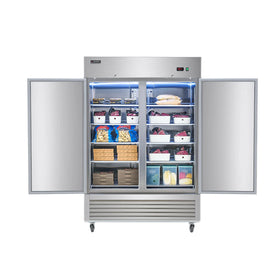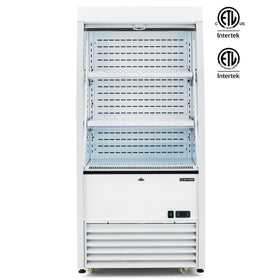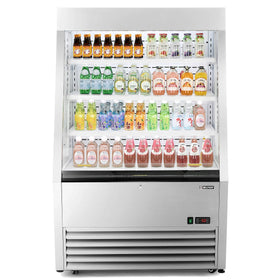A small amount of frost is acceptable -even necessary- in your commercial refrigerator. However, when the ice begins to build up, that’s when there is a problem. Frost buildup is bad news because it can slow down the efficiency of all activities in your kitchen, increase energy costs, and lead to costly repairs. There are several steps you can take to prevent or manage this issue, but in order to handle it effectively, you must understand why frost builds up in commercial refrigerators. Let’s discuss.
What is Frost, How Does it Form, and Where Does it Form?
To put it simply, frost forms in your refrigerator because warm, moist air comes into contact with the cold surfaces inside the refrigerator. There are cooling components in your refrigerator, and they absorb the heat from the food. When the moisture in the air hits them, it condenses and freezes.
This is why the condenser coils always get frozen up first. These coils are responsible for circulating refrigerant and absorbing heat, and this makes them crucial to maintaining the refrigerator's low temperature. When moisture freezes on these coils, frost begins to accumulate, and this does not bode well for your refrigerator.
What Happens When Frost Builds Up?
Again, a little frost is normal, but excessive frost is problematic. What excessive frost does is obstruct the smooth functioning of the refrigerators cooling systems and reduces overall efficiency. Then the temperatures begin to fluctuate, and if not taken care of, critical components of your refrigerators may begin to fail as well.
Most Common Causes of Frost Buildup
There are many causes of frost buildup, but if your refrigerator keeps freezing up, it is more than likely to be one or two of these common causes.
1. Frequent or Prolonged Door OpeningFrequent door opening is the most common cause of frost buildup, and unfortunately, it is basically inevitable, especially in a commercial kitchen. In commercial settings, it's common for refrigerator doors to be opened frequently, especially during busy periods like lunch or dinner service. Every time the door is opened, warm and humid air from the outside enters the refrigerator. This sudden flood of warm air increases the humidity inside, and more condensation happens on the cold surfaces. This eventually freezes and turns to frost.
Impact on the Refrigerator- Frost causes the refrigerator to work harder to maintain its set temperature, leading to increased energy consumption. In other words, the refrigerator consumes more power than normal, and your utility bills go higher.
- Excess frost also obstructs the airflow inside your fridge, leading to uneven cooling. This means there are hot spots in your refrigerator, and anything in those areas goes bad.
- Minimize door openings: An easy and practical way to prevent frost buildup in your commercial refrigerator is to instruct your staff to limit how often they open the refrigerator. When they do (because opening the fridge is inevitable), they must keep the door open for the shortest time possible.
- Install strip curtains or air curtains: Strip curtains are additional barriers that can prevent warm air from entering the refrigerator when the door is inevitably opened.
2. Worn or Damaged Door Gaskets
Door gaskets (seals) are rubber strips that line the interior of the refrigerator door. Their role is to act as an airtight seal when the refrigerator door is closed. These gaskets are effective in the short run, but over time, they can wear out, crack, or tear.
When this happens, it becomes easy for warm, moist air to seep into the refrigerator, even when the door is closed. This warm air raises the internal humidity and can contribute to frost buildup on the cooling elements.
Impact of Worn or Damaged Door Gaskets- Compromised seals can also lead to energy inefficiency and food spoilage.
- You may also notice that frost is more concentrated around the door or in areas close to the gasket.
- Inspect door gaskets regularly: Look for signs of wear, cracks, or tears.
- Replace damaged gaskets: The good news is that refrigerator gaskets are replaceable. If you find any damage, replace the gaskets to ensure a proper seal.
- Keep gaskets clean: Sometimes dirt or grease buildup can prevent the gaskets from sealing properly, so regular cleaning is important.
3. High Humidity in the Environment
A commercial kitchen can be really hot and humid, especially when cooking is in full swing. When the refrigerator door opens in such a high-humidity environment, more moisture enters, increasing the likelihood of frost buildup.
Impact of High Humidity- The higher the humidity in your kitchen, the faster frost will accumulate inside the refrigerator.
- High humidity can also increase condensation on the food and shelves, contributing to higher frosting on all interior surfaces.
- Control humidity levels: Ensure your kitchen has proper ventilation or dehumidifiers to keep humidity in check.
- Use covered containers for food storage: Open or uncovered food can release moisture into the air, contributing to frost buildup.
4. Blocked or Dirty Evaporator Coils
Evaporator coils are crucial for the functioning of your refrigerator, and you don’t want anything to obstruct them. These coils almost solely responsible for cooling your refrigerator because they remove heat from the air within the refrigerator.
Hence, when these coils are neglected and they eventually become blocked by stored food or become dirty, they cannot effectively remove moisture from the air. This moisture then freezes on the coils, and before you know it, there is excessive build up.
Impact of Blocked or Dirty Evaporator Coils- Blocked coils can also cause uneven cooling, leading to potential food spoilage.
- Dirty coils will also make the refrigerator work harder, reducing its efficiency and lifespan.
- Clean the coils regularly: Ensure that the evaporator coils are cleaned according to the manufacturer’s instructions. You can use professional repair service, if you are unsure.
- Avoid overcrowding: Do not store items too close to the coils, as this can block airflow and affect their ability to maintain the right temperature.
5. Malfunctioning Defrost System
Most modern commercial refrigerators come already equipped with an automatic defrost system. This system is usually really effective, and it periodically melts any accumulated frost. However, if this system fails or malfunctions, frost can build up quickly and reach excessive levels.
Impact of a Malfunctioning Defrost System- Without regular defrosting, frost can cover the evaporator coils, and the consequences could be costly. The cooling becomes inadequate, and the refrigerator is at risk of mechanical failure.
- A malfunctioning defrost system can also result in higher energy usage, as the refrigerator has to work harder to maintain the desired temperature.
- Check the defrost timer and heater: If you notice excessive frost, it may be due to a malfunction in the defrost system. You can check whether the defrost timer is functioning properly or whether the defrost heater is damaged.
- Call a professional technician: If you're unsure, it’s best to call a service technician to inspect and repair the defrost system.
Conclusion
Frost buildup in your commercial refrigerator should not be taken lightly because it can affect the efficiency and the long-run performance of your equipment. These tips will save you from higher energy bills, food spoilage, and costly repairs. For more tips on cleaning and maintaining your refrigerator, including how to defrost your commercial refrigerator, check out Wilprep.










